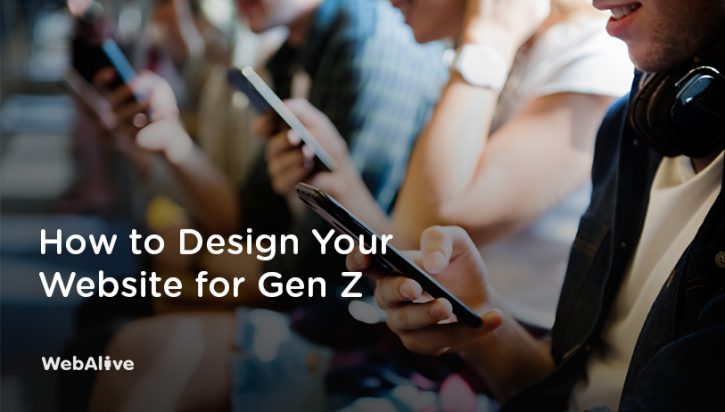
How to Design Your Website for Gen Z Users
People of different age groups have different for their user experience (UX) online.
Nowhere is this more apparent than in the habits and preferences of Generation Z (Gen Z) – the generation of young adults born after 1995.
Businesses must ensure their website design and experience engages this new generation of consumers according to their preferences.
Consider these 4 ways to format your web design for Gen Z users:
As Gen Z reaches adulthood and enters the workforce, they’ll bring billions in purchasing power and influence to the digital economy.
- Think like Amazon and YouTube
- Build an intuitive interface
- Optimize for mobile
- Create a strong brand experience
Think More Like Amazon and YouTube, Less Like Facebook
According to a recent survey from Visual Objects, Generation Z prefers the experience of YouTube and Amazon over Facebook.
This is an essential piece of information for small businesses and web designers because it shows that –
Generation Z prioritizes reliability and function over sleek or trendy web design.
YouTube and Amazon anticipate what their users are likely to want next and deliver personalized, recommended content.
Amazon’s home page, for example, is filled with personalized recommendations for products and videos.
These recommendations make the browsing experience personal and immersive – designed to keep users on the website as long as possible.
According to a 2018 report from Salesforce, Gen Z website users also value personalized experiences even if it means offering personal data.
Gen Z also avoids website with pop-ups – a feature that Amazon and YouTube avoid. Pop-ups and gated content annoy Generation Z users more than users of any other generation,
When planning the design of your website, lean toward reliability over aesthetics. Instead of putting content behind a gate or trying to sell your brand with pop-ups, personalise content to anticipate what actually interests your users.
Build a Simple and Intuitive Interface
Extravagant web design and special animations are not priorities for Gen Z websites users.
Instead, their primary concern is functionality, or being able to fulfill the intent that drove them to visit your website.
To meet this preference, you need:
- Functional design
- Intuitive navigation structure
- Fast loading speed
Popular web design trends include reducing the colours and symbols used to denote links and interactive content.
YouTube is an excellent example of a simple, intuitive navigation design.
Instead of colours and animation, YouTube presents a list of videos on a white background, with red buttons showing users where they can subscribe to more content they want. This simplified design makes navigating through content easy for website users.
Gen Z grew up on digital media, and website navigation is intuitive to them. Whether swiping and tapping a mobile phone or clicking their way around a website, they prefer “clean” websites without the clutter of unnecessary prompts.
Fast Page Load Times Keep People On Your Site
Most people will leave a website for good if that website is slow to load or they encounter an error page.
Keep users on your website by:
- Keeping page load speeds fast
- Avoiding distracting advertising or banners
- Ensure that your CTAs all lead to functional pages
If you want a faster website, avoid pop-ups or overloading your pages with content or features with heavy scripts.
To test your website’s speed as you develop its design, use Google PageSpeed Insights.
Google’s tool offers suggestions for creating faster load times.
Consult with a web designer to learn best practices for page load time.
Optimize for Multiple Devices
Gen Z users rely on their mobile devices for online browsing. To match this behaviour, your business needs to optimize your site for mobile to ensure their brand is accessible.
In addition to maintaining a consistent and intuitive UX across platforms, a mobile-friendly site helps your SEO, given that Google indexes mobile sites as the primary version of a website.
Mobile users should be able to swipe and tap their way around your site with the same intuition as they would on your desktop version.
Make sure your site is fully optimised for mobile, which goes beyond making images responsive.
Failure to optimize your site for mobile can result in slower page load times or improperly configured content.
Create a Strong Branding Experience
It’s essential that people recognize your brand across all of your digital properties. Make sure to align your website’s design with all of your social media channels.
Cater to Gen Z online behaviours by creating a seamless omnichannel and multi-device experience that features consistent branding and compelling, authentic content.
When crafting your brand, consider incorporating elements that Gen Z users prioritize when determining whether to purchase from a company, such as:
- Social responsibility
- Diversity and inclusion
- Video content
Investing in a robust social media presence is also an easy way for small businesses to meet Gen Z users where they are – specifically Instagram, YouTube, and Snapchat.
According to survey data from Euclid Analytics, 45% of Gen Z website users primarily find new brands on Instagram.
Establishing a consistent brand image across your entire digital presence retains the brand familiarity and paints your company as authentic.
Update Your Website Design for Generation Z
To engage Generation Z on your website, first gather inspiration from Amazon and YouTube, the websites Gen Z users visit most. Then, create a simple, intuitive website design that’s optimized for multiple channels and devices.
Take a clear and direct approach with navigation that’s organised and thoughtfully structured, and avoid annoying features such as pop-ups and banner ads.
Consider hiring a web design agency to help you follow these 4 steps to align your web design with the preferences of Gen Z users.
You read a lot. We like that
Want to take your online business to the next level? Get the tips and insights that matter.

